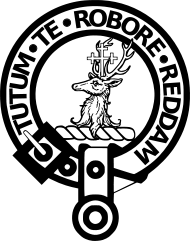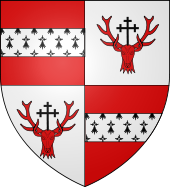- Clan Crawford
-
Clan Crawford Crest badge 
Crest: A stag's head erased Gules, between the attires a cross crosslet fitchée Sable Motto: Tutum te robore reddam Profile Region Lowlands District Renfrewshire[1] Chief Clan Crawford has no chief, and is an armigerous clan 
Arms of the last Chief of Clan Crawford Last Chief: Hugh Crawfurd of Auchinames[1] 21st Laird of Auchinames[1] Clan Crawford is a Scottish clan recognised by the Court of the Lord Lyon, which is the heraldic authority of Scotland. The clan does not a have a chief recognised by the Lord Lyon King of Arms, is considered an armigerous clan. Clan Crawford is considered armigerous because Crawfords are matriculated with the Lyon Court as armigers. The last internally recognised chief was Hugh Ronald George Craufurd, who sold his land (Auchenames, Crosbie and other estates) and moved to Canada in 1904. He died in Calgary in 1942, leaving no male heirs.
Contents
History
Clan Crawford derives its clan-name from the barony of Crawford in Lanarkshire, Scotland. Because of this it has been claimed the clan is of Norman descent, however it has also been asserted that the clan is of Anglo-Danish descent.[2] The most complete history of the House of Crawford was written by the historian George Crawfurd in the early 18th century. In line with George Crawfurd account, the House acknowledges as its progenitor the Anglo-Danish chief Thorlongus (Thor the tall) who is most closely identified with the Merse in Southern Scotland, a marshy area west of Berwick and north of the River Tweed. Thorlongus also held lands in Northumbria. He fled to Scotland in the winter of 1068–9 when William the Conqueror ravaged Northumbria. Thorlongus served under Malcom Cadmore during the Dano-Scottish war with William the Conqueror. He was granted lands in Ednam by King Edgar around 1107. Thorlongus is known in documents located in Durham Cathedral Archives as the Overlord of Crawford. Thorlongus' grandson Galfridus de Craufurd is the first to assume the surname.
The claims of a Reginald, supposedly a son of the Earl of Richmond, to be a Norman knight brought to Scotland by David I of Scotland as progenitor of the Crawfords is untenable, since the Durham Cathedral documents date from the early 12th century, during the reign of King Edgar and clearly name Thorlongus as Overlord of Crawford. Furthermore, Reginald was born after Gregan, his reputed grandson. Gregan is the knight who saved King David I's life from the attack of a stag in 1127AD that led to the grateful monarch founding Holyrood Abbey. Reginald de Craufurd as son of Galfridus lived at an earlier time, being born around 1075-80AD.[citation needed]
Galfridus de Craufurd divided the Barony of Crawford between his two sons, Hugh and Reginald, Hugh receiving the Barony and the portion given to Reginald became known as Crawfordjohn after Reginald's son John. John de Craufurd witnessed a charter of Abbott Arnold to Theobald Flamaticus for Douglas Water (date). Johannes de Crawford, great-great-grandson of Galfridus de Craufurd, through his eldest son Hugh (d. 1248), had two daughters – the youngest who married William Lindsay, ancestor of the Earls of Crawford. The eldest daughter Margaret married Archibald Douglas, progenitor of the Earls of Douglas. A later Reginald de Crawford, of the Crawfordjohn line, married James de Loudon's daughter and heir, Margaret. In 1196, during the reign of William I of Scotland, Sir Reginald Crawford was appointed Sheriff of Ayr. He was succeeded by his son, Hugh Crawford of Loudon, Sheriff of Ayr.[2]
From Sir Reginald of Loudoun descends the main branch of the Crawfords, named "of Auchinames." This branch of the clan received lands from Robert I of Scotland in 1320. From a younger son of the Sheriff descend the Crawfords of Craufurdland. This man's claim to the property was confirmed by Robert III of Scotland in 1391. The third branch of Crawfords are the Crawfords of Kilbirnie, who claim descent from Sir John of Crawfordjohn who lived c. 1255. The Crawfords of Kilbirnie acquired the Kilbirnie estates in 1499. A baronetcy was conferred upon this branch of the family in 1781.[3] Another important marriage of the Crawfords was that of Sir Reginald Crawford's sister Margaret and Sir Alan Wallace of Ellerslie. In 1781 a baronetcy was conferred to this branch of the clan.[2]
Modern Clan Crawford
 The Crawford tartan is derived from the Vestiarium Scoticum, first published in 1842.
The Crawford tartan is derived from the Vestiarium Scoticum, first published in 1842.
Clan Crawford does not have a chief recognised by the Lord Lyon King of Arms. Because of this the clan is considered an armigerous clan. The clan is currently unrepresented at the Standing Council of Scottish Chiefs. Sir Robert Craufurd, Baronet of Kilbirnie is the most senior member of the House of Crawford and represents it on the The Scottish Council of Armigerous Clans and Families.[4]
Clan symbolism
The modern crest badge of a member of Clan Crawford contains the crest: a stag's head erased Gules, between the attires a cross crosslet fitchée Sable.[3] Encircling the crest on the crest badge is a strap and buckle engraved with the motto: TUTUM TE ROBORE REDDAM which translates from Latin as "I will give you safety through strength".[2] The Crawford tartan is of relatively modern origin, and it is certain that there was no Crawford tartan in around 1739. The first record of a Crawford tartan is that of the "Crawfovrd" which appeared in the Vestiarium Scoticum of 1842. This is the Crawford tartan used today. The Vestiarium was the work of the Sobieski Stuarts who claim their book was a reproduction of ancient manuscript about clan tartans. Modern research, however, has shown it to be a Victorian era hoax. Even so, today many clan tartans are derived from the Vestiarium.[5]
An unusual death
John Craufurd of Craufurdland died in 1612, aged only 21, from an injury received at foot-ball. His widow married Sir David Barclay of Ladyland in the Parish of Kilbirnie, Ayrshire.[6]
See also
- Crawford Castle
- Giffordland, Ayrshire A cadet branch of the Craufurds of Craufurdland
References
- ^ a b c myclan.com
- ^ a b c d "Clan Crawford". Standing Council of Scottish Chiefs (clanchiefs.org). http://www.clanchiefs.org/?init=clanfinder&id=Crawford. Retrieved 24 April 2008.
- ^ a b Innes of Learney (1971). The tartans of the clans and families of Scotland (8th edition ed.). Edinburgh: Johnston and Bacon. pp. 102–103..
- ^ "Clan Crawford". Clan Crawford Association (clancrawford.org). http://www.clancrawford.org/. Retrieved 24 April 2008.
- ^ "Tartan – Crawford". Scottish Tartans World Register (scottish-tartans-world-register.com). http://www.scottish-tartans-world-register.com/tartan.aspx?record=1515. Retrieved 26 September 2008.
- ^ Robertson, George (1823), A Genealogical Account of the Principal Families in Ayrshire, more particularly in Cunninghame. Vol.1. Pub. Irvine: Cunninghame press. p. 197.
External links
Scottish clans Clans with chiefs Agnew · Anstruther · Arbuthnott · Arthur · Bannerman · Barclay · Borthwick · Boyd · Boyle · Brodie · Broun · Bruce · Buchan · Burnett · Cameron · Campbell · Carmichael · Carnegie · Cathcart · Charteris · Chattan · Chisholm · Cochrane · Colquhoun · Colville · Cranstoun · Crichton · Cumming · Darroch · Davidson · Dewar · Drummond · Dunbar · Dundas · Durie · Elliot · Elphinstone · Erskine · Farquharson · Fergusson · Forbes · Forsyth · Fraser · Fraser of Lovat · Gayre · Gordon · Graham · Grant · Gregor · Grierson · Guthrie · Haig · Haldane · Hamilton · Hannay · Hay · Henderson · Home · Hope · Hunter · Irvine · Jardine · Johnstone · Keith · Kennedy · Kerr · Kincaid · Lamont · Leask · Lennox · Leslie · Lindsay · Lockhart · Lumsden · Lyon · MacAlister · MacBain · MacDonald · Macdonald of Clanranald · MacDonald of Keppoch · Macdonald of Sleat · MacDonell of Glengarry · MacDougall · Macdowall · MacIntyre · Mackay · Mackenzie · Mackinnon · Mackintosh · Maclachlan · Maclaine of Lochbuie · MacLaren · MacLea (Livingstone) · Maclean · MacLennan · MacLeod · MacLeod of Lewis · MacMillan · Macnab · Macnaghten · MacNeacail · MacNeil · Macpherson · MacTavish · MacThomas · Maitland · Makgill · Malcolm (MacCallum) · Mar · Marjoribanks · Matheson · Menzies · Moffat · Moncreiffe · Montgomery · Morrison · Munro · Murray · Napier · Nesbitt · Nicolson · Ogilvy · Oliphant · Primrose · Ramsay · Rattray · Riddell · Robertson · Rollo · Rose · Ross · Ruthven · Sandilands · Scott · Scrymgeour · Sempill · Shaw · Sinclair · Skene · Spens · Stirling · Strange · Stuart of Bute · Sutherland · Swinton · Trotter · Urquhart · Wallace · Wedderburn · Wemyss · Wood ·
Armigerous clans Abercromby · Abernethy · Adair · Adam · Aikenhead · Ainslie · Aiton · Allardice · Anderson · Armstrong · Arnott · Auchinleck · Baillie · Baird · Balfour · Bannatyne · Baxter · Bell · Belshes · Bethune · Beveridge · Binning · Bissett · Blackadder · Blackstock · Blair · Blane · Blyth · Boswell · Brisbane · Buchanan · Butter · Byres · Cairns · Calder · Caldwell · Callender · Campbell of Breadalbane · Campbell of Cawdor · Carruthers · Cheyne · Chalmers · Clelland · Clephane · Cockburn · Congilton · Craig · Crawford · Crosbie · Cunningham · Dalmahoy · Dalrymple · Dalzell · Dennistoun · Don · Douglas · Duncan · Dunlop · Edmonstone · Fairlie · Falconer · Fenton · Fleming · Fletcher · Forrester · Fotheringham · Fullarton · Galbraith · Galloway · Gardyne · Gartshore · Ged · Gibsone · Gladstains · Glas · Glen · Glendinning · Gray · Gunn · Haliburton · Halkerston · Halket · Hepburn · Heron · Herries · Hogg · Hopkirk · Horsburgh · Houston · Hutton · Inglis · Innes · Kelly · Kinloch · Kinnaird · Kinnear · Kinninmont · Kirkcaldy · Kirkpatrick · Laing · Lammie · Langlands · Learmonth · Little · Logan · Logie · Lundin · Lyle · MacAulay · Macbrayne · MacDuff · MacEwen · MacFarlane · Macfie · Macgillivray · MacInnes · MacIver · Mackie · MacLellan · Macquarrie · Macqueen · Macrae · Masterton · Maule · Maxton · Maxwell · McCorquodale · McCulloch · McKerrell · Meldrum · Melville · Mercer · Middleton · Moncur · Monteith · Monypenny · Mouat · Moubray · Mow · Muir · Murray of Atholl · Nairn · Nevoy · Newlands · Newton · Norvel · Ochterlony · Orrock · Paisley · Paterson · Pennycook · Pentland · Peter · Pitblado · Pitcairn · Pollock · Polwarth · Porterfield · Preston · Pringle · Purves · Rait · Ralston · Renton · Roberton · Rossie · Russell · Rutherford · Schaw · Seton · Skirving · Somerville · Spalding · Spottiswood · Stewart · Stewart of Appin · Strachan · Straiton · Strange · Sydserf · Symmers · Tailyour · Tait · Tennant · Troup · Turnbull · Tweedie · Udny · Vans · Walkinshaw · Wardlaw · Watson · Wauchope · Weir · Whitefoord · Whitelaw · Wishart · Young
Culture and society Scotland · Clan chief · Septs · Clan badge · Clan crest · Clan battles · Tartan · Bagpipes · Clearances · Kilt · Manrent · The Highlands · Battle of Culloden · Highland games · Border Reivers · Scottish heraldry · Scottish surnames
Categories:- Armigerous clans
- Scottish clans
- Scoto-Norman clans
Wikimedia Foundation. 2010.
